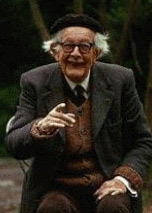
Project #3
I recently discovered a book called Ramps and Pathways: A Constructivist Approach to Physics with Young Children. Not only is the book incredibly inspiring for educators of all ages, but it credits the man, the myth, the legend: Jean Piaget.
If you haven't heard of him, I highly recommend getting to know everything about his work.

For now, I just want you to know that Piaget was a HUGE supporter of physical knowledge.
In Ramps and Pathways, we learn that by exploring with ramps, balls, and risers, children can develop scientific skills at many levels. In fact, I recently put this to the test by building my own set of ramps and gathering various pathways for children to explore with.

For now, I just want you to know that Piaget was a HUGE supporter of physical knowledge.
In Ramps and Pathways, we learn that by exploring with ramps, balls, and risers, children can develop scientific skills at many levels. In fact, I recently put this to the test by building my own set of ramps and gathering various pathways for children to explore with.
Here is the set that I made!
The ramps in the pictures below are cement tubes from Home Depot, playground padding, and carpet tubes.






















